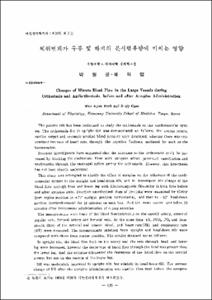KUMEL Repository
1. Journal Papers (연구논문)
1. School of Medicine (의과대학)
Dept. of Medical Education (의학교육학)
체위변화가 두부 및 하지의 분시혈류량에 미치는 영향
- Alternative Author(s)
- Park, Won Kyun; Chae, E Up
- Journal Title
- 대한생리학회지
- ISSN
- 0300-4015
- Issued Date
- 1985
- Abstract
- The passive tilt has been performed to study the orthostasis on the cardiovascular system. The orthostasis due to upright tilt was demonstrated as follows: the venous return, cardiac output and systemic arteiral blood pressure were decreased, whereas there was concomitant increase of heart rate, through the negative feedback mediated by such as the baroreceptor . Previous investigators have suggested that the tolerance to the orthostasis could he increased by blocking the cholinergic fiber with atropine which prevented vasodilation and bradycardia through the vasovagal reflex during the orthostasis. However, this hypothesis has not been clearly understood. This study was attempted to clarify the effect of atropine on the tolerance of the cardiovascular system to the upright and head-down tilt, and to investigate the change of the blood flow through head and lower leg with Electromagnetic flowmeter in both tilts before and after atropine state. Fourteen anesthetized dogs of 10∼14kg were examined by tilting from supine position to +77∘ upright position (orthostasis), and then to −90∘ head-down position (antiorthostasis) for 10 minutes on each test. And the same course was taken 20 minutes after intravenous administration of 0.5mg atropine. The measurements were made of the blood flow(ml/min.) on the carotid artery, external jugular vein, femoral artery and femoral vein. At the same time pH, PCO2 , PO2 and hematocrit (Hct) of the arterial and venous blood, and heart rate(HR) and respiratory rate (RR) were measured. The measurements obtained from upright and head-down tilt were compared with those from supine position. The results obtained are as follows: In upright tilt, the blood flow both on the artery and the vein through head and lower leg were decreased, however the decrement of blood flow through the head was greater than the lower leg And the atropine attenuated the decrement of the blood flow on the carotid artery, but not on the vessels of the lower leg. HR was moderately increased in upright tilt, but slightly in head-down tilt. The percent change of HR after the atropine administration was smaller than that before the atropine state in both upright and head-down tilts. Before the atropine state, RR was decreased in upright tilt, whereas increased in head-down tilt. However after the atropine state, the percent change of RR was smaller than that of before the atropine state in both upright and head-down tilts. In upright tilt, venous PCO2 was increased, but arterial PO2 and venous PO2 were slightly decreased. Hct was increased in both upright and head-down tilts. The findings of blood PCO2 , PO2 and Hct were not interferred by the atropine. In conclusion, 1;he administration of atropine is somewhat effective on improving the cardiovascular tolerance to postural changes. Thus, atropine attenuates the severe diminution of the blood flow to the head during orthostasis, and also reduces the changes of HR and RR in both orthostasis and antiorthostasis.
기립 및 도립의 체위면화가 두부 및 하지의 혈액순환계에 미치는 영향을 관찰하고, atropine의 정주에 의한 부교감신경의 차단이 체위변화에 대한 심맥관계의 내성을 증가시키는 지를 보기위하여 개를 경사대에 수평위로 고정하여 수동적으로 기립 및 도립위로 체위를 변화시키고, 각 체위에서 10분간 유지시켜 경동맥, 외경정맥, 고동맥 및 고정맥의 분시 혈류량, 분시 심박수 및 분시 호흡수, 그리고 혈액의 pH, PCO2 , PO2 및 Hct를 측정하였다. 다시 수평위에서 atropine 0.5mg을 1회 정주한 후 위의 실험과정을 반복하여 시행하고 atropine투여전과 비교 관찰하였던 바 다음과 같은 결과를 얻었다. 기립시 두부 및 하지 동정맥혈의 분시 혈류량은 감소하였고, 특히 두부로 가는 혈류량의 감소가 더 컸으나, atropine의 투여는 경동맥의 분시 혈류량의 감소를 억제하였다. 도립시 두부 및 하지의 분시 혈류량은 유의한 변화를 보이지 않았고, 개체에 따라 변화양상도 다르게 나타났다. atropine의 투여는 투여전에 비하여 유의한 차이를 보이지 않았다. 분시 심박수는 기립 및 도립시 모두 증가하였다. atropine의 투여는 수평위에서 분시 심박수는 투여전 보다 증가하나, 체위변화에 의한 분시 심박수의 증가를 경감시켰다. 분시 호흡수는 개체에 따라 변화양상에 차이가 있으나, 대체로 기립시는 감소하고 도립시는 증가하였다. atropine의 투여는 기립 및 도립시 다 같이 분시 호흡수의 변화를 억제하였다. 혈액소견은 기립시 정맥철의 pH 및 PO2 는 감소하였고, PCO2 는 증가하나 동맥혈의 PCO2 는 감소하였다. 도립시 동정맥혈의 소견은 수평위에 비해 별 변화가 없었으며 , atropine의 투여후도 기립 및 도립시 모두에서 투여전에 비하러 유의한 변하는 없었다. Hct는 기립 및 도립시 증가하였으며 atropine투여에 의한 변화는 관찰할 수 없었다. 이상에서와 같이 atropine의 투여는 기립시 두부로 가는 혈류량을 증가시키며, 기립 및 도립시 발생할 수 있는 분시 심박수의 과도한 증가를 억제함으로서 체위변화에 대한 심맥관계의 내성을 증가시키는데 어느정도 효과가 있다고 하겠다.
- Alternative Title
- Changes of Minute Blood Flow in the Large Vessels during Orthostasis and Antiorthostasis, before and after Atropine Administration
- Publisher
- School of Medicine
- Citation
- 박원균 et al. (1985). 체위변화가 두부 및 하지의 분시혈류량에 미치는 영향. 대한생리학회지, 19(2), 139–153.
- Type
- Article
- ISSN
- 0300-4015
- Appears in Collections:
- 1. School of Medicine (의과대학) > Dept. of Medical Education (의학교육학)
1. School of Medicine (의과대학) > Dept. of Physiology (생리학)
- 파일 목록
-
-
Download
 oak-bbb-1577.pdf
기타 데이터 / 733.74 kB / Adobe PDF
oak-bbb-1577.pdf
기타 데이터 / 733.74 kB / Adobe PDF
-
Items in Repository are protected by copyright, with all rights reserved, unless otherwise indicated.